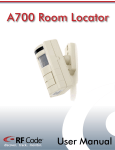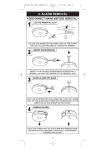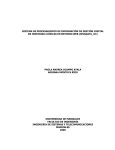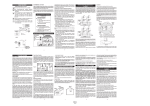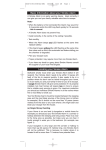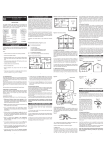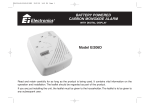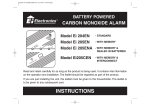Download Ei Electronics EI105C Specifications
Transcript
13425-R1-12V COMMON-UC 29/9/09 7:56 AM Page 1 12 VOLT RELAY SMOKE & HEAT ALARMS IONISATION MODEL Ei100R3 HEAT MODEL Ei103R OPTICAL MODELS Ei105R3 Ei105R4* INSTRUCTION LEAFLET Contains vital information on unit operation and installation. Read and retain carefully. If you are just installing this unit this leaflet MUST be given to the householder. * The Ei105R4 operating range 8 to 16V Basic informat © Ei Electronics 2009 P/N B13425 Rev 1 READ THIS FIRST IDEALLY INSTALL IN THE CENTRE OF CEILING AT LEAST 300mm (12”) FROM LIGHT FITTINGS. KEEP ION-ISATION ALARMS AWAY FROM KITCHENS TO PREVENT NUISANCE ALARMS. INTERCONNECT ALL ALARMS. ENSURE THE 12V PANEL CONNECTED TO THE ALARMS. IS CORRECTLY DO NOT FIT ACTUAL ALARM UNTIL ALL BUILDING WORK IS COMPLETED TO AVOID CONTAMINATION. AFTER CHECKING OPERATION, COVER SMOKE ALARM WITH DUST COVER UNTIL REQUIRED FOR USE. LOCATE IONISATION ALARMS (Ei100R3) AWAY FROM KITCHENS TO PREVENT NUISANCE ALARMS. IF A NUISANCE ALARM OCCURS, FAN THE ALARM VIGOROUSLY WITH A NEWSPAPER TO HELP CLEAR THE SENSOR. TEST WEEKLY - PRESS THE BUTTON FOR 10 SECONDS AND A RED LIGHT BEHIND THE BUTTON OR ON THE COVER SHOULD FLASH. INTERCONNECTED ALARMS WILL ALSO SOUND. 1 13425-R1-12V COMMON-UC 29/9/09 7:56 AM Page 2 READ THIS FIRST CONT. CLEAN YOUR SMOKE ALARM REGULARLY. THIS WILL REDUCE THE RISK OF FALSE ALARMS. REMOVE OR COMPLETELY COVER YOUR SMOKE ALARM WHEN REDECORATING TO PREVENT DUST OR OTHER CONTAMINATION DAMAGING THE UNIT. DO NOT PAINT OR ALLOW PAINT, WATER OR DUST TO CONTAM-INATE YOUR ALARM. IT MAY CEASE TO OPERATE. IF YOUR ALARM SOUNDS FOR NO REASON AND WILL NOT RESET, IT CAN BE REMOVED BY UNSCREWING THE WIRES FROM THE TERMINAL BLOCK AND UNSCREWING THE UNIT FROM THE CEILING / WALL. LOCATING ALARMS SMOKE ALARMS Sufficient smoke must enter the Smoke Alarm before it will respond. The Smoke Alarm needs to be within 7.5 metres (25 ft) of the fire to respond quickly. It also needs to be in a position where its alarm can be heard throughout your home, so it can wake the occupants in time for all to escape. A single Smoke Alarm will give some protection if it is properly installed, but most homes will require two or more to ensure that a reliable early warning is given. For maximum protection you should put individual Smoke Alarms in all the rooms where fire is most likely to break out, (apart from kitchens, bathrooms & garages (see Locations to Avoid). A Smoke Alarm should be located between the sleeping area and the most likely sources of fire (living room or kitchen for example), But it should not be more than 7.5 metres (25ft) from the door to any room where a fire might start. Fit an interconnected alarm within 3m (10ft) of all bedroom doors, so the alarm will be heard. Important: This Smoke Alarm is designed for a single occupancy in a residential type environment. HEAT ALARMS The Heat Alarm gives a fire warning when the temperature at the unit reaches 58° C. It is ideal for kitchens, garages, boiler houses and other areas where there are normally high levels of fumes, smoke or dust i.e. places where Smoke Alarms cannot be installed without the risk of excessive nuisance alarms. A Heat Alarm should only be used in a room adjoining an escape route, in conjunction with Smoke Alarms on the escape routes. 2 13425-R1-12V COMMON-UC 29/9/09 7:56 AM Page 3 Protection Levels Minimum Protection Recommended Protection All the Heat Alarms and Smoke Alarms should be interconnected to ensure the early warning will be heard, particularly by somebody sleeping. A properly designed early warning fire system ensures the alarm is given before the escape routes become blocked with smoke. Therefore there must be Smoke Alarms along the escape routes as Heat Alarms would not give sufficient warning. However, a fire in a closed room (e.g. kitchen) adjoining the escape route, can eventually cause the corridor to become smoke-logged due to smoke leaking out from around the door before adequate warning can be given by detectors in the corridor. (Smoke leaking out from a room is often cool and slow moving so it can take a long time to rise to the ceiling, and travel to a detector which could be some distance away). A Heat Alarm in the closed room will give early warning of fire in that roomand help overcome this problem. Figure 1 illustrates where Heat Alarms and Smoke Alarms should be located in a typical two storey house. Note the spacings in “Protection Levels” which ensure the early detection of fire and that the warning will be heard. Locate Heat Alarms in rooms adjoining or on escape routes kitchens, garages, boiler houses etc. where Smoke Alarms are unsuitable. Install within 5.3m (17 feet) of potential sources of fire. 3 13425-R1-12V COMMON-UC 29/9/09 7:56 AM Page 4 Single Storey Dwelling If the Home is on one level (a bungalow or mobile home for example) you should put the first Smoke Alarm in a corridor or hallway between the sleeping and living areas. Place it as near to the living area as possible, but make sure you can hear it loudly enough to wake a person in the bedrooms. (for example, see figure 2). If the bungalow is very large and the corridor or hallway is more than 15 metres (50 ft) long, one Smoke Alarm will not be sufficient. This is because no matter where it is located it will be more than 7.5 metres from potential fires. In houses with more than one sleeping area, Smoke Alarms should be placed between each sleeping area and the living area. Multi Storey Dwellings If the home is on more than one level the best place for the first Smoke Alarm is in the downstairs hallway near the stairs. This is because smoke is likely to be detectable in the hallway before it reaches the upstairs landing and bedrooms. The second Smoke Alarm should be upstairs, because the 4 13425-R1-12V COMMON-UC 29/9/09 7:56 AM Page 5 downstairs Smoke Alarm is unlikely to detect the smoke from a fire in a bedroom upstairs (see figure 1). Recommended Protection For recommended protection you should put individual Smoke Alarms in all the rooms where fire is most likely to break out (apart from the locations to avoid, mentioned below). Ensure that they are all interconnected. The living room is the most likely place for a fire to start at night, followed by the kitchen and then the dining room. You should also consider putting Smoke Alarms in any bedrooms where fires might occur, for instance, where there is an electrical appliance such as an electric blanket or heater, or where the occupant is a smoker. You could also consider putting Smoke Alarms in any rooms where the occupant is unable to respond very well to a fire starting in the room, such as an elderly or sick person or a very young child. Checking you can hear the Smoke & Heat Alarms With the Alarm sounding in its intended location, check you are able to hear it in each bedroom with the door closed, above the sound of the radio. The radio should be set to a reasonably loud conversation level. If you can’t hear it over your radio the chances are that it wouldn’t wake a person. If a Smoke Alarm is too far away for it to wake a person, it is best to interconnect it to another Smoke Alarm or Heat Alarm near the bedroom. The following alarms Ei100R3, 105R3, 105R4 & 103R can be interconnected - when one alarm senses smoke, all interconnected alarms respond (see below for further details). LOCATIONS TO AVOID Don’t place Smoke Alarms in any of the following areas: • Bathrooms, kitchens, shower rooms, garages or other rooms where the smoke alarm may be triggered by steam, condensation, normal smoke or fumes. Keep at least 6 metres (20 feet) away from sources of smoke - wall mounting if necessary. Don’t place Heat Alarms in any of the following areas: • Bathrooms, shower rooms or other room where the unit may be triggered by steam or condensation. Don’t place Smoke or Heat Alarms in any of the following areas: • Places where the normal temperature can exceed 40°C (104°F) or be below 4°C (39°F) e.g. attics, furnace rooms etc. Directly above ovens or kettles, as the heat/steam could cause nuisance alarms. • Near a decorative object, door, light fitting, window molding etc., that may prevent smoke or heat from entering the Alarm. • Surfaces that are normally warmer or colder than the rest of the room (for example attic hatches, uninsulated exterior 5 13425-R1-12V COMMON-UC 29/9/09 7:56 AM Page 6 walls etc). Temperature differences might stop smoke or heat from reaching the unit. • Next to or directly above heaters or air conditioning vents, windows, wall vents etc. that can change the direction of airflow. • In very high or awkward areas (eg. over stair shafts) where it may be difficult to reach the alarm (for testing or hushing). • Locate away from very dusty or dirty areas as dust build-up in the chamber can impair performance. It can also block the insect screen mesh and prevent smoke from entering the smoke detector chamber. • Locate the unit at least 1 metre (3 feet) from dimmer controlled lights and wiring - some dimmers can cause interference. • Locate unit at least 1.5m (5 feet) and route wiring at least 1m (3 feet) away for fluorescent light fittings as electrical “noise” and/or flickering may effect the unit. • Do not locate in insect infested areas. Small insects getting into the smoke detector chamber can cause intermittent alarms. Insects and contamination on the Heat Alarm sensor can increase its response time. POSITIONING SMOKE & HEAT ALARMS The location must comply with applicable building regulations. Ceiling Mounting Hot smoke rises and spreads out, so a central ceiling position is the preferred location. The air is “dead” and does not move in corners, therefore Smoke & Heat Alarms must be mounted away from corners. Place the unit at least 300mm (12 inches) from any light fitting or decorative object which might obstruct smoke / heat entering the Smoke Alarm. Keep at least 300mm (12 “) away from walls. See figure 3. Figure 3 IDEAL IN CENTRE OF CEILING Figure 4 15 TO 30 cm (6-12") 90 cm (3 FEET) DEAD AIR SURFACES NEVER WITHIN 15cm OF ANY CORNER On a sloping Ceiling In areas with sloping or peaked ceilings install your Alarm 90 cm (3 feet) from the highest point measured horizontally (see figure 4), because “dead air” at the apex may prevent smoke/heat from reaching the unit. 6 13425-R1-12V COMMON-UC 29/9/09 7:56 AM Page 7 Wall Mounting (Smoke Alarm only) When a ceiling position is not practical (for example on a ceiling having exposed beams or joists, or built-in radiant heating) put the top edge of your Smoke Alarm between 150 and 300mm (6 and 12 inches) below the ceiling. Keep at least 300mm (12 inches) from room corners. (see figure 3). Wall mounting is not recommended for Heat Alarms. INSTALLATION INSTRUCTIONS IMPORTANT PRECAUTION: Do not install the actual smoke/heat alarm itself in new or renovated buildings until all work is completed (including floor coverings) and the building has been fully cleaned. The wiring can be installed when appropriate. (Excessive dust and debris from building work can contaminate the smoke chamber and cause problems, it will also invalidate the guarantee). If it must be installed, cover it completely, particularly around the edges, with a dust cover (eg. a plastic bag), until all cleaning is finished. For the Smoke Alarms remove the cover by opening with the tab and, then separating at the rear snap-in hinges by folding over backwards. For the Heat Alarms just leave the cover open, as it is attached to the base by wires. Connect wires to the unit as in wiring diagram (see figure 5), using the terminal block. Low voltage / low current cable is required, consistent with the number of Smoke/Heat Alarms on the circuit. The 7 13425-R1-12V COMMON-UC 29/9/09 7:56 AM Page 8 maximum recommended cable resistance is 20 ohms. All wiring must comply with local codes. Screw unit to ceiling using screws provided. Put cover back on the Smoke Alarm by matching up hinges and gently snapping it on to the base. Caution: (a) The Smoke/Heat Alarm must be wired to a 12V supply that is permanently on. (b) Positive air pressure at wiring openings, conduit or mounting boxes/holes can cause draughts through and away from the Smoke/Heat Alarm which may prevent correct operation. Any such openings must be sealed (with silicone rubber or similar) to prevent unwanted air movement. Interconnecting Smoke Alarms and Heat Alarms When a fire is sensed the alarm must be given throughout the house. Up to twelve (12) Smoke Alarms (models Ei100R3, Ei105R3 & Ei105R4 only) and Heat Alarms (model Ei103R only) can be interconnected so that when one senses fire all alarm. Do not interconnect to any other type of alarm. The unit initiating the alarm can be identified by its LED flashing every second. Figure 6 shows the interconnect wiring. These Alarms should be interconnected only within the confines of a single family living unit. If they are interconnected between different units there may be excessive nuisance alarms. Everybody may not be aware that they are being tested or that it is a nuisance alarm caused by cooking etc. 8 13425-R1-12V COMMON-UC 29/9/09 7:56 AM Page 9 After Installation Test all units by pressing the test buttons in sequence. The Smoke/Heat Alarm horn should sound within 10 seconds and the relay contacts should change over about 4 seconds after the horn sounds. All interconnected alarms should sound within 10 seconds. When the button is released the Alarm will stop and the relay contacts will change back about 4 seconds later. Check that the chosen control panel is correctly recording the alarm condition. If the unit fails to operate correctly check the connections and the panel carefully. Check the unit is receiving power and that the voltage is within specification. CHECKING & MAINTAINING YOUR ALARMS INSPECTION & TESTING PROCEDURE It is recommended that you test your Smoke/Heat Alarms at least once a week to be sure the unit is working. It will also help you and your family to become familiar with the sound of the Alarm. Press the test button (see figure 6) for up to 10 seconds to ensure the sensor, electronics and sounder are working. A red light behind the test button or on the cover will flash every second while horn is sounding. The alarm will stop when the button is released. Pressing the test button simulates the effect of smoke/heat during a real fire and is the best way to ensure the Alarm is operating correctly. Figure 6 WARNING: DO NOT TEST WITH FLAME This can set fire to your Alarm and damage your house. We do not recommend testing with smoke or heat as the results can be misleading unless special apparatus is used. CLEANING YOUR ALARM Clean your Alarms regularly,particularly in dusty areas. Use the narrow nozzle attachment of your vacuum cleaner to remove dust, insects and cobwebs from the sides and cover slots where the smoke or heat enters. To clean the cover, wipe with a damp cloth. Dry cover thoroughly with a lint free cloth.With Smoke Alarms if the contamination around the outer case indicates that the area is particularly dirty, remove the Alarm from the ceiling. Check that the openings in the black smoke sensing chamber are not clogged by visually inspecting them after opening the cover of the Smoke Alarms. If they are clogged - an extermely rare occurance - the Smoke Alarm must be replaced. WARNING: Do not paint your Alarm. 9 13425-R1-12V COMMON-UC 29/9/09 7:56 AM Page 10 Other than the cleaning described above, no other customer servicing of this product is required. Repairs, when needed, must be performed by the manufacturer. All Smoke Alarms are prone to dust and insect ingress which can cause false alarms or failure to alarm. The latest design, materials and manufacturing techniques have been used in the construction of our Alarms to minimize the effects of contamination. However it is impossible to completely eliminate the effect of dust and insect contamination, and therefore, to prolong the life of the Alarm you must ensure that it is kept clean so that excess dust does not build up. Any insects or cobwebs in the vicinity of the Alarm should be promptly removed. In certain circumstances even with regular cleaning, contamination can build up in the smoke sensing chamber causing the alarm to sound or fail. If this happens the alarm must be returned to the manufacturer for servicing or replacement. Contamination is beyond our control, it is totally unpredictable and is considered normal wear and tear. For this reason, contamination is not covered by the guarantee and a charge is made for servicing such units. If you experience persistant nuisance alarms with the Ei100R3 Ionisation alarm due to cooking fumes you could consider replacing it with an Optical Alarm (Ei105R3 or Ei105R4) as they are significantly less susceptible to cooking fumes. If you experience persistent false alarms, in particular locations, due to contamination of the optical smoke chamber (models Ei105R3 & Ei105R4) you could consider replacing Optical Smoke Alarms (Ei105R3) with Ionisation Smoke Alarms (Ei100R3). Ionisation type alarms are less susceptible to dust than Optical type alarms. Heat Alarms are the most immune to contamination(Ei103R). NUISANCE ALARMS Alarms caused by cooking fumes etc. can be readily silenced by fanning the unit with a newspaper or similiar. If, when the alarm goes off, there is no sign of smoke, heat or noise to indicate that there is a fire, you should get your family into a safe place, before you start investigating. Check the house carefully in case there is a small fire smouldering somewhere. Check whether there is some source of smoke or fumes, for example cooking fumes being drawn past the Smoke Alarm by an extractor. If there are frequent nuisance/false alarms it may be necessary to re-locate the device away from the source of the fumes. If for some reason an alarm continues to sound without smoke or heat being present (due to insect infestation or 10 13425-R1-12V COMMON-UC 29/9/09 7:56 AM Page 11 contamination build-up for example) the alarm can be silenced by disconnecting the 12 Volt supply. Disconnect the alarm with the red light flashing - as the rest are probably satisfactory. IMPORTANT SAFEGUARDS When using household protective devices, basic safety precautions should always be followed, including those listed below: • Please read all instructions. • Rehearse emergency escape plans so everyone at home knows what to do in case the alarm sounds. Further information can be obtained from the Home Office or from your local fire prevention officer. • To maintain sensitivity to smoke/heat, do not paint or cover the alarm in any manner; do not permit any accumulation of cobwebs, dust or grease. • If unit has been damaged in any way or does not function properly,do not attempt a repair. Return Alarm (see - Getting your Alarm Serviced). • This appliance is only intended for premises having a residential type environment. • Smoke / Heat Alarms are not a substitute for insurance. The supplier or manufacturer is not your insurer. • The chamber inside the Ionisation (Ei100R3) Smoke Alarm contains a small amount of radioactive material (33kBq of Americium 241). Do not tamper with the chamber. You may safely install and clean the Smoke Alarm following this leaflet’s instructions. • In the UK & Republic of Ireland please contact us at the nearest address at the end of this booklet for information on repair and/or disposal. • Do not dispose of your Alarm in a fire. PLANNING YOUR ESCAPE ROUTE FOR WHEN THE ALARM GOES OFF Use the Smoke / Heat Alarm Test Buttons to familiarize your family with the Alarm sound and to practice fire drills regularly with all family members. Draw up a floor plan that will show each member at least 2 escape routes from each room in the house. Children tend to hide when they don’t know what to do. Teach children how to escape, open windows, and use roll up fire ladders and stools without adult help. Make sure they know what to do if the alarm goes off - see below. 11 13425-R1-12V COMMON-UC 29/9/09 7:56 AM Page 12 1. Check room doors for heat or smoke. Do not open a hot door. Use an alternate escape route. Close doors behind you as you leave. 2. If smoke is heavy, crawl out, staying close to floor. Take short breaths, if possible, through a wet cloth or hold your breath. More people die from smoke inhalation than from flames. 3. Get out as fast as you can. Do not stop for packing. Have a prearranged meeting place outside for all family members. Check everybody is there. 4. Call the Fire Brigade from a neighbour’s house. Remember to give your name and address. 5. NEVER re-enter a burning house. Limitations of Smoke / Heat Alarms Smoke/Heat Alarms have significantly helped to reduce the number of fire fatalities in countries where they are widely installed. However independent authorities have stated that they may be ineffective in some circumstances. There are a number of reasons for this: • The Alarms will not work if 12 Volt power supply is off or if they are not connected properly. • Smoke / Heat Alarms will not detect fire if sufficient smoke / heat does not reach the alarm. Smoke / heat may be prevented from reaching the Alarm if the fire is too far away, for example, if the fire is on another floor, behind a closed door, in a chimney, in a wall cavity, or if the prevailing air draughts carry the smoke/heat away. Installing Smoke / 12 13425-R1-12V COMMON-UC 29/9/09 7:56 AM Page 13 Heat Alarms on both sides of closed doors and installing more than one Smoke / Heat Alarm as recommended in this leaflet very significantly improves the probability of early detection. • The Alarm may not be heard. • A Smoke / Heat Alarm may not wake a person who has taken drugs or alcohol. • Smoke / Heat Alarms may not detect every type of fire to give sufficient early warning. They are particularly ineffective with: fires caused by smoking in bed, escaping gas, violent explosions. poor storage of flammable rags and/or liquids, (for example petrol, paint, spirits etc), overloaded electrical circuits, arson and children playing with matches. • Smoke / Heat Alarms don’t last indefinitely. For example if there is build up of contamination performance will be impaired. The manufacturer recommends replacement of the Smoke / Heat Alarms after 10 years as a precaution (see ‘Replace by’ label on side of unit). What is the best Smoke Alarm - Optical or Ion ? Both types respond in all standard fires but each type may respond faster to particular fires as shown. The EI company manufactures complementary 12 Volt Smoke Alarms , Optical Smoke Alarm Ei105R3 & Ei105R4 and Ionisation Smoke Alarm Ei100R3. For dual protection install each type. Optical Sensor Best for slow smouldering fires - large smoke particles Ion Sensor Best for fast flaming fires - small smoke particles GETTING YOUR ALARM SERVICED If your Smoke/Heat Alarm fails to work after you have carefully read all the instructions, checked the unit has been installed correctly, and is receiving power (red light flashing every 40 seconds) contact Customer Assistance at the address given at the end of this leaflet. If it needs to be returned for repair or replacement put it in a padded box and send it to “Customer Assistance and Information” at the nearest address given on the Alarm or in this leaflet. State the nature of the fault, where the Alarm was purchased and the date of purchase. 13 13425-R1-12V COMMON-UC 29/9/09 7:56 AM Page 14 FIVE YEAR PRODUCT GUARANTEE Ei Electronics guarantees this product (excluding battery) against any defects that are due to faulty material or workmanship for a five year period after the original date of consumer purchase or receipt as a gift. This guarantee does not include damage to the product resulting from accident or misuse. It also excludes incidental and consequential damages. If the product should become defective within the warranty period, we will replace it free of charge. (see “Getting Your Smoke Alarm Serviced”) Do not interfere with the product or attempt to tamper with it. This will invalidate the guarantee. This guarantee is in addition to your statutory rights as a consumer. SPECIFICATIONS (Ei100R3) Sensor: Sensitivity: Source: Airspeed: Button Test: Dual Ionisation Chamber Complies with BS EN 14604: 2005 33kBq of Am241 No false alarms up to 22mph (10M/s) Simulates the effect of smoke and checks chamber, electronics and horn. (Ei105R3 & Ei105R4) Sensor: Sensitivity: Source: Airspeed: Button Test: Ambient Light: Automatic Self-Test: Insect Screen: Optical, uses light scatter from smoke Complies with BS EN 14604: 2005 Contains no radioactive material Essentially immune to the effect of airspeed. Simulates the effect of smoke and checks chamber, electronics and horn. Chamber housing design and electronic compensation overcomes problems with stray light. Smoke Chamber is tested every 40 Sec. and unit beeps (without LED flash) if it is degraded. Prevents insects or debris entering chamber (Ei103R) Sensor: Sensitivity: Fast responce Thermistor 54°C +/- 4°C (fixed temp.) Complies with BS 5446: 2003 MODELS (Ei100R3. Ei105R3 & Ei103R) Supply Voltage: 10.2 to 14.0 Volts Standby Current: 150 Microamps (max) Alarm Current: 30 to 60 mA 14 13425-R1-12V COMMON-UC 29/9/09 7:56 AM Page 15 MODEL (Ei105R4) Supply Voltage: 8.0 to 16.0 Volts Standby Current: 250 Microamps (max) Alarm Current: 20 to 60 mA Cable: Multicore low voltage signal cable. Maximum resistance 20 ohms Power-On Indicator: Alarm: LED flashes every 40 seconds Electronic Piezoelectric horn in unit 85dB @3M Alarm Sound Output: Alarm Status: 85dB(A) (minimum) at 3m LED flashes every second on unit sensing fire Temperature Range: Humidity Range: Relay Contacts: Interconnect: Dimensions: Weight: 4 to 40°C (39 to 104°F) 0% to 90% Relative Humidity. 24 Volts/1 Amp (resistive), normally closed and normally open. Up to 12 Ei100R3 / 105R3 / 105R4 / 103R only can be interconnected. Max cable resistance 20 ohms. LED flashes every second to identify the unit sensing fire. (I/O line can supply 3.5 volts at 4 mA) (Ei100R3) 140 x 125 x 46 mm (Ei105R3) 140 x 125 x 46 mm (Ei105R4) 140 x 125 x 46 mm (Ei103R) 140 x 125 x 58 mm 170 grams (6 oz) Specifications are subject to change TROUBLESHOOTING ALARM SOUNDS FOR NO APPARENT REASON: (1) Identify the alarm source. On all interconnected units, the red light under the test button or on the cover will flash rapidily only on the unit which is the source of the alarm. (2) Check for fumes, steam etc. from the kitchen or bathroom. Paint and other fumes can cause nuisance alarms. (3) Fan the unit vigorously with a newspaper to disperse fumes. (4) If alarm does not stop, disconnect the 12V supply. INTERCONNECTED ALARM DO NOT ALL SOUND: (1) Hold test button for 10 seconds after first alarm has sounded to ensure signal is transmitted to all units. (2) Check that cables have been correctly connected and that the connections are tight. 15 13425-R1-12V COMMON-UC 29/9/09 7:56 AM Page 16 FREQUENT NUISANCE ALARMS OCCUR: (1) Close kitchen / bathroom door when in use. (2) Ensure that the alarm is sited at least 6m away from sources of fumes. (3) Contamination from insects, paint or paint fumes may have occured. (see “Clean your Alarm”). (4) If the problem persists, resiting of the unit should be considered. Alternatively, replace the unit with an Optical unit, assuming that the problem is with an Ionisation type alarm. Ei Electronics. Shannon, Co. Clare, Ireland. e-mail. [email protected] Ei Electronics. 9 Grundy St., Liverpool L5-9SG. Phone: +44 (0)151 2981588. Fax: +44 (0)151 2073312. e-mail: [email protected] The crossed out wheelie bin symbol that is on your product indicates that this product should not be disposed of via the normal household waste stream. Proper disposal will prevent possible harm to the environment or to human health. When disposing of this product please separate it from other waste streams to ensure that it can be recycled in an environmentally sound manner. For more details on collection and proper disposal, please contact your local government office or the retailer where you purchased this product. Construction Product Type: Smoke Alarm Devices European Standard: EN14604:2005 Certificate of Conformity: 0086-CPD-537430 MODEL TYPE Ei100R3 Ionisation 12V Smoke Alarm Ei105R3 Optical 12V Smoke Alarm Ei105R4 Optical 8-16V Smoke Alarm 0086 08 16
















